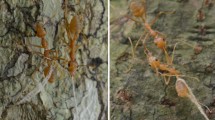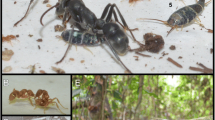Summary:
Aggression assays are commonly used to study nestmate recognition in social insects. Methods range from detailed behavioral observations on small numbers of insects to counts of individuals fighting in group interactions. These assays vary in the equipment used and the intensity and duration of observations. We used the Argentine ant, Linepithema humile, to compare four aggression bioassays for consistency between replicates, similarity between assays, and ability to predict whole colony interactions. The assays included were 1 live – 1 dead ant interactions, live 1-1 battles, live 5-5 battles, and 1 ant introduced to a foreign colony. We tested six ant colonies in all pairwise combinations using four different assays and two to three scoring methods per assay. We also conducted a colony merging experiment to see which assays were capable of predicting this ecologically important event. We found that scoring methods within assays yielded very similar results, giving us no reason to favor observationally intense procedures, such as continuous scanning, over less observationally intense systems, such as snapshot surveys. Assays differed greatly in their consistency between replicates. No two replicates of the 1 live – 1 dead assay were significantly correlated. The live 5-5 and the colony introduction assays were the most consistent across replicates. The mean scores of the live 1-1, live 5-5 and colony introduction assays were all significantly correlated with each other; only the live 5-5 assay was significantly correlated with the 1 live – 1 dead assay. Assays that utilized the greatest number of live ants were the most likely to reveal high levels of aggression. The aggression scores of all but the 1 live – 1 dead assay were positively correlated with the number of ants that died during whole colony encounters and negatively associated with colony merging. We conclude that all live ant assays tested are useful tools for analyzing aggressive interactions between colonies, but that the pairing of a live and dead ant produced inconsistent results and generally lower levels of aggression. We found relatively low consistency between trials using the live 1-1 assay, but found that with sufficient replication its results were highly correlated with the assays using more interacting ants. We suggest that isolated aggressive acts in assays do not necessarily predict whole colony interactions : some colonies that fought in bioassays merged when the entire colonies were allowed to interact.
Similar content being viewed by others
Author information
Authors and Affiliations
Additional information
Received 8 April 2002; revised 26 November 2002; accepted 2 January 2003.
RID="*"
ID="*"Current address: University of Virginia, Blandy Experimental Farm, 400 Blandy Farm Lane, Boyce, Virginia 22620, USA, e-mail: thr8z@virginia.edu
Rights and permissions
About this article
Cite this article
Roulston, T., Buczkowski, G. & Silverman, J. Nestmate discrimination in ants: effect of bioassay on aggressive behavior. Insectes soc. 50, 151–159 (2003). https://doi.org/10.1007/s00040-003-0624-1
Issue Date:
DOI: https://doi.org/10.1007/s00040-003-0624-1




